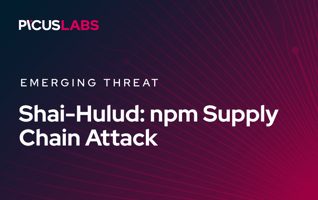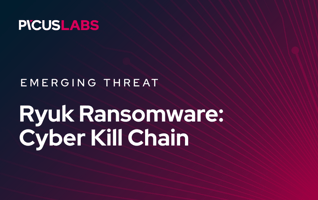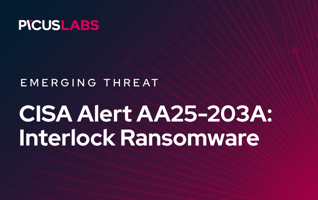What Is Advanced Persistent Threat (APT)?
An Advanced Persistent Threat (APT) is a highly targeted, multi-stage cyberattack where a skilled, well-funded adversary, often state-sponsored, infiltrates a network and establishes a long-term, secret presence. Using sophisticated tools, they move quietly through the system to steal sensitive data, such as intellectual property or government secrets, or prepare for sabotage, all while actively evading detection for months or even years.
In this post, we're going to break down exactly what an Advanced Persistent Threat (APT) is, explore their core characteristics, detail the typical attack lifecycle, and much more to give you a complete understanding of this sophisticated cyber threat.
Core Characteristics of APT Operations
Sponsorship & Support (State or Organized Groups)
APT operators typically receive state backing or organized criminal support, giving them access to zero-day exploits, custom malware frameworks, and extensive command-and-control infrastructure. This level of resourcing allows them to sustain campaigns against governments, defense, and critical industries without the financial pressure common to cybercrime groups.
Strategic, Long-Term Objectives
APTs prioritize persistence over quick wins. Their objectives often include data exfiltration, intellectual property theft, or pre-positioning for disruption. They use multi-stage kill chains, establish redundant access (e.g., multiple C2 channels, credential reuse), and operate “low and slow” to avoid detection while achieving strategic mission goals.
Stealth & Sophistication Techniques
Intrusions often begin with spear-phishing or exploitation of unpatched and zero-day vulnerabilities, followed by privilege escalation and lateral movement via credential dumping, Kerberos ticket abuse, or exploitation of Active Directory. Persistence is maintained through registry modifications, scheduled tasks, or firmware/rootkit implants. Groups like APT29 exemplify this by layering custom loaders, modular malware, and encrypted communications to stay hidden.
Evasion and Anti-Forensics Methods
To evade detection, APTs use encrypted C2 over HTTPS/DoH, domain fronting, and traffic shaping to mimic normal network flows. They rely heavily on “living off the land” binaries (e.g., PowerShell, WMI, PsExec) and fileless malware to reduce signatures. Anti-forensic tactics include timestomping, log wiping, in-memory payloads, and planting deceptive artifacts to mislead attribution efforts. These techniques complicate both detection and post-incident forensic analysis.
APT Attack Lifecycle
APT operations unfold in well-defined, repeatable phases.
Below is a realistic lifecycle derived from observed campaigns, mapped to techniques from MITRE ATT&CK and aligned with public reporting by CISA and Picus Labs. It is important to note that not every attack cycle will look exactly like the one shown here.
Rather than a strict template, this should be treated as a representative example, a way to understand attackers’ methodology based on their objectives.
Initial Reconnaissance
Attackers begin with passive and active intel gathering. This includes:
-
OSINT: Scanning public sources, LinkedIn, GitHub, company job posts, press releases.
-
Network Mapping: DNS records, exposed IPs, cloud assets.
-
Target Profiling: Identifying vulnerable software, employee email formats, VPN portals.
In some APT campaigns, metadata from leaked PDFs or misconfigured cloud buckets exposed internal IP ranges and AD structures, accelerating intrusion planning.
Initial Access & Infiltration
Entry is typically gained via:
-
Spear-phishing with malicious attachments (e.g., CVE exploits in RTF/DOCX).
-
Drive-by downloads from watering hole sites or SEO poisoning.
-
Exploitation of public-facing apps, like ProxyShell or Ivanti EPMM vulns.
-
Supply chain compromise: injecting malicious code into vendor software.
Example: UNC3886 exploited vCenter’s lack of EDR visibility in isolated ESXi environments to infiltrate Chinese telecom networks.
Establishing Foothold & Persistence
Post-access, attackers deploy malware and configure persistence mechanisms:
-
Remote Access Tools (RATs): Cobalt Strike, Sliver, or custom implants.
-
Web shells: e.g., China Chopper, dropped on IIS servers.
-
Persistence Techniques:
-
Windows: HKCU\Software\Microsoft\Windows\CurrentVersion\Run
-
Linux: Cron jobs, .bashrc, systemd units.
-
Cloud: IAM abuse or adding rogue SSH keys to EC2 instances.
-
APT groups often maintain redundant access across hosts and user accounts to survive detection and removal.
Command-and-Control (C2) Setup
Backdoors establish outbound C2 channels to attacker infrastructure:
-
Protocols: HTTPS, DNS tunneling, WebSocket, or even Slack/Telegram APIs.
-
Evasion Tactics:
-
Domain fronting to hide traffic in legitimate CDNs.
-
Custom TLS certificates to mimic trusted services.
-
Fast-flux DNS or bulletproof hosting.
-
Picus Labs observed malware like PlugX and ShadowPad using port 443 communications embedded in legitimate-looking HTTP headers.
Privilege Escalation & Credential Theft
To gain administrative control:
-
Exploitation: Local privilege escalation (e.g., PrintNightmare, CVE-2021-34527).
-
Credential Dumping: Tools like Mimikatz to extract hashes, cleartext creds, Kerberos tickets.
-
Token Theft: Hijacking browser sessions or abusing cloud access tokens.
In Kerberoasting scenarios, attackers request service tickets (TGS) for accounts with SPNs, then brute-force offline to recover cleartext passwords.
Lateral Movement
Attackers pivot using stolen credentials and built-in protocols:
Techniques:
-
PsExec, RDP, WinRM, WMI, or SMB.
-
SSH key reuse on Unix systems.
-
Exploiting trust relationships or weak segmentation.
They often use “Living off the Land” binaries (LOLBins) like rundll32, wmic, and certutil to avoid AV/EDR detection. Active Directory tools like BloodHound help visualize privilege paths.
Data Staging, Exfiltration & Follow‑Up Attacks
Sensitive data is aggregated and exfiltrated:
-
Staging: Compressing files with rar/7zip, sometimes double-encrypted.
-
Exfil Channels:
-
Direct HTTP POST to C2
-
DNS over HTTPS
-
Cloud storage (e.g., Google Drive, Dropbox API abuse)
-
Some APTs deploy dual-purpose malware: first for espionage, later for destructive attacks (e.g., ransomware, wipers) to cover tracks or extort victims.
Example: Sandworm APT used data-wiping malware (WhisperGate) after months of stealthy data collection in Ukraine.
Maintaining Presence & Long-Term Access
Even after objectives are met, APT actors remain dormant for future use:
-
Redundant persistence: multiple implants across endpoints, domain controllers, and edge devices.
-
Account hijacking: creation of fake admin users or backdoored MFA flows.
-
Tool rotation: changing C2 infrastructure and malware variants over time.
APT29, for example, was known to re-access previously breached networks via forgotten OAuth tokens and legacy service accounts.
What Stands Out APT Groups with Their Techniques
APT groups operate with stealth, patience, and technical sophistication far beyond commodity cybercriminals.
Fileless Execution & LOLBin Abuse
APT actors continue to favor fileless tradecraft and living-off-the-land binaries (LOLBins) to evade detection and persist covertly.
-
Execution vectors: mshta.exe, regsvr32.exe, rundll32, WMI, PowerShell, scheduled tasks.
-
Memory-only payloads: Implants decrypted and executed entirely in RAM; zero disk footprint.
-
Recent examples:
-
APT28’s HATVIBE backdoor delivered via malicious .hta file using mshta.exe.
-
GHOSTSPIDER backdoor sideloaded through regsvr32.
-
Chinese “EggStreme” loader decrypted payloads on-the-fly for in-memory execution.
-
Lazarus Group hid malicious code inside macOS extended file attributes, loaded at runtime.
-
Why it matters: These techniques bypass AV/EDR signatures, leave minimal forensics, and are hard to attribute.
Cloud Services as Covert C2
Modern APTs exploit trusted cloud infrastructure to conduct stealthy C2 and data exfiltration.
-
Cloud APIs: Microsoft Graph (Outlook, OneDrive), Google Drive, Slack, Telegram.
-
Tunneling services: Cloudflare Argo Tunnel, Ngrok, and Visual Studio Code Remote Tunnels.
-
Recent examples:
-
Trojan.Grager used OneDrive + Graph API for data exchange.
-
Chinese APT abused VS Code tunnels to maintain remote shell access via Azure infra.
-
APTs encrypted commands in Outlook email subjects and responses in attachments.
-
Why it matters: Cloud-based C2 evades DNS/IP blacklists, blends into normal enterprise traffic, and is nearly invisible to traditional perimeter controls.
Kernel-Level Persistence & BYOVD
APT groups are increasingly using Bring Your Own Vulnerable Driver (BYOVD) to disable security tools and maintain rootkit-level control.
-
Abused drivers: Signed but exploitable kernel drivers (e.g., from gaming software or OEM vendors).
-
Persistence methods:
-
Installing custom drivers to kill EDR processes.
-
Loading malicious kernel-mode implants that survive OS hardening.
-
-
Recent examples:
-
Iranian toolkits like DEMODEX used driver-based stealth.
-
Widespread abuse of Microsoft’s driver signing pipeline and vulnerable third-party drivers.
-
Why it matters: Kernel-mode access defeats EDR, survives reboots, and is nearly undetectable from user space.
Identity & Token Abuse in Hybrid Cloud
APT groups are prioritizing cloud-first identity compromise over endpoint exploitation.
-
Key techniques:
-
Forging or stealing OAuth2 / SAML tokens.
-
Adding rogue credentials to service principals.
-
Gaining shadow admin via app consent abuse.
-
-
Recent examples:
-
Storm-0558 forged Azure AD tokens using a stolen signing key.
-
SolarWinds attackers minted fake SAML assertions for persistent Microsoft 365 access.
-
Malware stole browser session cookies to hijack authenticated cloud sessions.
-
Why it matters: These methods allow undetectable lateral movement into SaaS, often without triggering login alerts or MFA challenges.
AI-Augmented Social Engineering
Generative AI is enabling scalable, hyper-realistic social engineering across APT campaigns.
-
Tools used: ChatGPT-like LLMs, WormGPT, deepfake engines, synthetic media generators.
-
Recent examples:
-
Kimsuky created fake military ID cards using AI image generation.
-
Lazarus used AI-generated recruiters and fake job interviews to lure developers.
-
Phishing-as-a-service kits now support auto-personalized emails with LLMs.
-
Why it matters: AI amplifies believability, automates targeting, and enables rapid multilingual phishing, increasing compromise rates across sectors.
Prominent APT Groups & Campaigns
China-aligned
-
Volt Typhoon: Specializes in infiltrating U.S. critical infrastructure with living-off-the-land and stealthy VPN exploitation. Their operations are designed for long-term sabotage preparation rather than immediate disruption.
-
APT41 (Double Dragon / Barium / Mission2025): A dual-purpose espionage and financially motivated group. They deployed new evasive malware families like DodgeBox and MoonWalk with DLL sideloading.
-
APT31 (Zirconium / Judgment Panda): Conducts global espionage against governments and dissidents abroad. In 2024–25, they cooperated with other Chinese groups to attack Russian networks.
-
Mustang Panda (TA416 / RedDelta / Earth Preta / Hive0154 / Fireant): One of the most active Chinese APTs in 2025, using phishing lures, USB malware, and the Pubload backdoor. Their campaigns frequently target NGOs, governments, and Tibetan groups.
-
DigitalRecyclers: Focused on espionage against European government and maritime sectors. They used anonymization infrastructure and custom backdoors such as RClient and HydroRShell.
-
Flax Typhoon: Built a botnet of over 260,000 routers and IoT devices. Their campaigns hit Taiwan, U.S. critical sectors, and allied networks using common software exploits.
-
Glacial Panda: Known for long-term cyberespionage operations. Frequently associated with advanced custom malware implants.
-
Salt Typhoon / Charcoal Typhoon (Microsoft aliases): Subclusters under Microsoft’s naming convention. These labels track Chinese actors engaged in espionage across Asia, the U.S., and Europe.
Russia-aligned
-
APT29 (Cozy Bear / Nobelium / Midnight Blizzard): A long-running SVR espionage unit targeting diplomats, NGOs, and government systems. Recent activity included WinRAR exploits and Teams-based phishing.
-
APT28 (Fancy Bear / Strontium / Forest Blizzard): A GRU military intelligence group aggressively exploiting zero-days like GooseEgg. In 2024–25, they focused on NATO, Ukraine, and Western governments.
-
Sandworm (GRU destructive ops): Russia’s destructive cyber unit. Deployed the ZEROLOT wiper against Ukrainian energy and telecom networks in 2024–25.
-
Star Blizzard (SEABORGIUM / Callisto Group): FSB-linked phishing actor specializing in credential theft. Recently adopted WhatsApp and QR-code lures to bypass MFA.
-
Gamaredon (Primitive Bear / Aqua Blizzard): Among the most active groups against Ukraine, using high-volume phishing. Deployed a new stealer called PteroBox in 2025.
-
Wizard Spider (Indrik Spider): Russian cybercriminal syndicate behind Ryuk, Conti, and other ransomware operations. They often overlap with state interests despite being profit-driven.
North Korea-aligned
-
Lazarus Group: Continues to blend espionage with financial cybercrime. In 2025, they stole hundreds of millions from crypto exchanges and exploited Chrome zero-days.
-
Kimsuky (APT43 / Thallium): DPRK espionage group targeting think tanks, diplomats, and academics. Known for malware-free phishing and use of AI-generated IDs in social engineering.
Iran-aligned
-
Charming Kitten (APT35 / Mint Sandstorm / Phosphorus): IRGC-linked actor impersonating journalists and scholars. Their MediaPl backdoor has been used against academics and policy experts.
-
MuddyWater (Static Kitten / Seedworm): MOIS-linked actor involved in regional espionage and destructive ops. Known for abusing commercial remote admin tools.
Unattributed / Emerging
-
Scattered Spider (UNC3944 / 0ktapus / Muddled Libra): A notorious cybercrime group with APT-like sophistication. They specialize in SIM-swapping, identity attacks, and ransomware deployment.
-
Silver Fox: Reported by Intel471 in 2025 targeting Taiwan. Leveraged RATs like Gh0stCringe and HoldingHands against government networks.
-
TetrisPhantom: Identified by Kaspersky in late 2024 as spreading via Trojanized USB software. Focused on espionage against government institutions.
Main Goals of Advanced Persistent Threat (APT) Attacks
Cyber Espionage and Intelligence Gathering
The most common goal of APTs is to steal sensitive data from governments, defense, and high-value industries. Groups like Mustang Panda and APT28 continued spying on European governments and militaries in 2024–2025, while China-linked actors targeted semiconductor companies to steal intellectual property. Espionage remains the backbone of state-sponsored APT operations.
Financial Gain and Cryptocurrency Theft
Some APTs, especially North Korea–aligned groups, focus on revenue. In 2024–2025, campaigns targeted crypto exchanges and fintech, including the Bybit hack ($1.5B stolen) and Lazarus’ use of supply-chain attacks like the 3CX compromise. These attacks fund regimes and blur the line between espionage and cybercrime.
Hacktivism and Ideological Causes
Hacktivist groups, often aligned with states, use APT-level tools for political causes. Russia–Ukraine conflict spurred hundreds of activist groups since 2022, while Middle East tensions in 2023–2024 drove website defacements and DDoS campaigns. “Hacktivism” increasingly overlaps with state interests, making attribution difficult.
Sabotage and Critical Infrastructure Disruption
Some APTs aim to damage or disrupt critical infrastructure. Russia’s Sandworm deployed the ZEROLOT wiper against Ukraine’s energy sector in 2025, showing how destructive malware is used in warfare. Similar campaigns have hit power grids, transportation, and industrial systems, underlining growing sabotage risks.
Industries Most at Risk from APTs
-
Government & Defense: top targets for espionage.
-
Energy & Critical Infrastructure: highly exposed to sabotage.
-
Financial & Cryptocurrency: frequent victims of theft and fraud.
-
Manufacturing & Industrial: targeted for IP and supply chain disruption.
-
Telecom & Technology: infiltrated for surveillance and supply-chain access.
Impact & Consequences of APT Intrusions
The consequences can be broadly categorized into financial, operational, and reputational damage.
Financial and Economic Consequences
-
Theft of Intellectual Property (IP): This is often a primary goal, resulting in the theft of trade secrets, patents, product designs, and confidential research and development data. The long-term economic damage from losing a competitive advantage can be immense and is often difficult to quantify.
-
Massive Financial Losses: This includes the direct costs of incident response, forensic investigation, remediation, system recovery, and increased security measures.
-
Regulatory Fines and Legal Costs: Breaches of sensitive data, especially personally identifiable information (PII) or protected health information (PHI), can lead to significant fines under regulations like GDPR or HIPAA, along with civil litigation.
-
Cyber Espionage for Competitive Advantage: Stolen data, such as strategic business plans, merger and acquisition details, or financial reports, can be sold to rival corporations or nation-states, giving them a significant market edge.
Operational and Sabotage Consequences
-
Sabotage of Critical Infrastructure: APT groups may target and gain control over critical functions, leading to the disruption, manipulation, or complete deletion of essential organizational infrastructures like databases, operational technology (OT) systems, or industrial control systems (ICS).
-
Operational Downtime and Disruption: The need to investigate, contain, and remediate a deep intrusion can lead to an extensive slowdown or complete shutdown of business operations for an extended period, which directly impacts productivity and revenue.
-
Persistence and Re-entry Risk: APT attackers often establish backdoors and multiple persistent access points.Even after an organization believes it has cleaned up the intrusion, the attackers can retain unauthorized, hidden access for months or years to re-engage the attack or continue espionage.
-
Compromise of Supply Chain: Attacking a specific organization may involve first compromising a less-secure partner or vendor (a supply chain attack), which then spreads the disruption and compromise throughout a trusted ecosystem.
Reputational and Strategic Consequences
-
Loss of Public and Investor Trust: An APT intrusion often results in the loss of highly sensitive customer, employee, or government data, severely damaging the brand's reputation and eroding confidence among customers, partners, and investors.
-
National Security Threats: When government or defense contractors are targeted, the consequence is the theft of military secrets, state secrets, and classified documents, posing a significant risk to national security.
-
Compromised Data Integrity: In some cases, the goal is not just to steal data but to subtly alter or manipulate data(e.g., financial reports, intellectual property documents) to cause internal confusion, operational errors, or long-term damage that is difficult to trace.
-
Employee Morale and Turnover: The breach can lead to low employee morale, internal investigations, and high-level management changes, including the firing of security and IT personnel.
Prevention & Mitigation Strategies
Foundational Security Controls (WAF, NGFW, EDR, IPS, IDS, DLP)
The first layer of defense against APTs is built on proven security controls that reduce the attack surface and stop common threats before they escalate. While individually effective, their real strength comes from operating together as part of a layered defense strategy.
-
WAF: Shields web applications from injection and cross-site scripting attempts, often the initial entry vector for APTs targeting internet-facing assets.
-
NGFW: Goes beyond traditional firewalls with deep packet inspection, application awareness, and segmentation to limit lateral movement once attackers gain a foothold.
-
IPS/IDS: Detects and blocks known attack signatures as well as anomalous traffic patterns; particularly valuable in identifying command-and-control (C2) channels.
-
EDR: Provides endpoint-level visibility, detecting suspicious behaviors such as persistence creation, credential dumping, or privilege escalation attempts.
-
DLP: Reduces the risk of sensitive data exfiltration—a key objective of most APT campaigns—by monitoring and controlling data transfers across networks, devices, and cloud.
To maximize effectiveness, these controls must be:
-
Continuously updated to reflect evolving adversary tactics.
-
Integrated with threat intelligence to proactively block indicators linked to known APT groups.
-
Hardened with best practices like timely patch management, least-privilege access, multi-factor authentication, and network segmentation to prevent attackers from exploiting weak points.
Together, these measures provide the foundation for defending against persistent and adaptive threats while enabling higher-level detection and response strategies to operate effectively.
Advanced Detection & Response Technologies
APT actors thrive on stealth, making advanced detection indispensable. Beyond foundational controls, organizations should adopt capabilities that correlate signals across domains and uncover hidden threats.
-
XDR unifies endpoint, network, identity, and cloud telemetry for correlation and faster detection.
-
NDR and NTA provide insights into abnormal traffic patterns and command-and-control attempts.
-
UEBA spots deviations in user or entity behavior, such as unusual logins or sudden data transfers.
-
Threat Hunting enables proactive searches for APT presence, especially in logs and network traffic.
-
Deception and Canaries lure attackers into revealing themselves.
-
SOAR automates responses to accelerate containment and reduce attacker dwell time.
These technologies rely on continuous detection engineering, ensuring coverage evolves with adversary tactics.
Breach & Attack Simulation (Adversary Simulation vs. Emulation)
Even the best controls must be validated.
Breach & Attack Simulation (BAS) tools provide a systematic way to measure how defenses hold up against real-world threats.
-
Adversary Simulation replicates known attack techniques to confirm defenses against documented threats.
-
Adversary Emulation goes further by modeling how specific threat actors operate, testing defenses against their TTPs.
By combining both, organizations can test resilience against what attackers have done and what they could do. BAS exercises aligned to MITRE ATT&CK uncover blind spots, validate detection rules, and provide evidence-based prioritization for improvements.
User Awareness on Phishing Attacks
APTs often begin with social engineering, particularly spear-phishing. Even sophisticated technical defenses fail if users are unaware of the threats.
-
Regular, role-specific training on phishing, credential theft, and malicious attachments.
-
Phishing simulations to measure susceptibility and provide immediate feedback.
-
Reinforcement of password hygiene and multi-factor authentication practices.
-
Education on broader social engineering tactics, including vishing and impersonation.
Embedding awareness into daily workflows turns employees into an additional line of defense.
Incident Response & Recovery Planning
Given the persistence of APTs, organizations must plan for compromise. Effective incident response minimizes damage and accelerates recovery.
-
Playbooks tailored to scenarios like data exfiltration or ransomware.
-
Defined roles for technical, legal, communications, and executive stakeholders.
-
Tabletop exercises to rehearse decision-making under pressure.
-
Forensic readiness to capture evidence and support root-cause analysis.
-
Backup and recovery strategies that are tested, immutable, and ideally air-gapped.
-
Post-incident reviews that feed lessons learned back into detection, controls, and training.
Strong IR not only limits the impact of an incident but also strengthens defenses for future encounters.
Frequently Asked Questions (FAQs)
Examples of APTs include APT28 (Fancy Bear), targeting NATO and Ukraine; APT29 (Cozy Bear), linked to the SolarWinds supply-chain breach; APT40 (Periscope), active in maritime and defense sectors; APT41 (Wicked Panda), known for global espionage and financial theft; Mustang Panda, focused on governments and NGOs in Europe and Asia; Lazarus Group (APT38), behind the WannaCry ransomware and cryptocurrency thefts; Sandworm, responsible for destructive attacks on Ukraine; Gamaredon, active with large-scale phishing campaigns; and Volt Typhoon, targeting U.S. critical infrastructure with stealthy tactics.
APT groups use a focused, multi-stage approach for network infiltration. Their primary initial access tactics include highly tailored spear phishing campaigns targeting key personnel and exploiting zero-day or unpatched vulnerabilities in public-facing applications. Once a foothold is established, they install backdoors for persistence, move laterally through the network to escalate privileges, and use covert Command and Control (C2) channels to ultimately exfiltrate sensitive data while diligently evading detection.
APT attacks are characterized by stealth, a long duration (months or years), and a primary goal of espionage or intellectual property theft. The attacker wants to remain undetected. Ransomware attacks are characterized by speed, widespread execution, and an immediate goal of financial extortion.The attacker wants the victim to know they've been compromised right away to enforce payment.
Yes, certain industries are significantly more vulnerable to Advanced Persistent Threat (APT) attacks because they possess assets highly sought after by state-sponsored actors. The most common targets include the Government and Defense sectors for classified intelligence; Technology and Manufacturing for valuable intellectual property and trade secrets; Energy and Utilities as critical national infrastructure; and Financial Services for direct monetary theft and economic disruption. Healthcare and Pharmaceutical companies are also frequently targeted for lucrative medical research and sensitive patient data, making their value the primary factor that draws persistent, long-term espionage campaigns.
The main goals of Advanced Persistent Threat (APT) attacks are typically strategic and long-term, moving beyond simple financial crime. Primary objectives include cyber espionage for stealing intellectual property, trade secrets, or state secrets, and financial gain through high-value heists or ransoms. Additionally, state-sponsored groups may aim for sabotage or destruction of critical infrastructure (like energy grids) or to simply gain a persistent, undetectable foothold in a network to monitor activity and prepare for future operations.



.png?width=353&height=200&name=Ivanti-EPMM-ET-preview-sept25%20(1).png)




